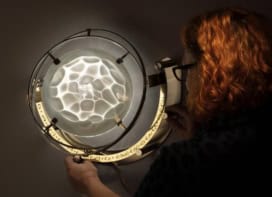By Margaret Harris in Washington, DC
Greetings from Washington, DC, where the 2011 meeting of the American Association for the Advancement of Science is getting off to a gentle start this afternoon before the firehose of information switches on tomorrow.
Between today and Monday (17–21 February) there will be more scientific symposia, plenary talks, career workshops and poster sessions here in America’s capital city than you can shake a very large stick at. In fact, there’s so much going on that I’m not the only one from physicsworld.com attending this year: my colleague Michael Banks is navigating DC’s excellent Metro system as I type this, and between the two of us we’ll try to bring you as much of the conference’s physics news as possible.
One of the themes of this year’s conference is interdisciplinary science, and that was certainly on display at this afternoon’s press briefing on adaptive optics. Regular readers of Physics World will already know that adaptive optics is not just for astronomers anymore – we published a feature by Alan Greenaway on adaptive optics in cell biology just a few months ago, in August 2010 – but it was still surprising to find an astronomer (Norbert Hubin of the European Southern Observatory) sharing the stage with a biophysicist (Eric Betzig of the Howard Hughes Medical Institute) and an opthalmologist (Joseph Carroll, Medical College of Wisconsin).
Hubin, of course, is interested in adaptive optics on a grand scale – tools like laser guide stars, and systems of actuators that can make 100 adjustments to a telescope mirror every milisecond, producing images up to three times sharper than the Hubble Space Telescope despite Earth’s turbulent atmosphere.
Betzig, for his part, uses genetic engineering to label clumps of mouse neurons with a fluorescent marker. Once the mouse matures, these glowing clumps become his “guide star” when he images processes that take place up to 500 microns below the surface of a live mouse’s brain.
And Carroll is using adaptive optics to image the human retina on a cellular level, with the goal of diagnosing diseases like glaucoma and diabetic retinopathy at earlier stages, before they cause irreversible damage. “We hope to be able to tell people 10 years before they would have known otherwise that they have this disease, and then treat them,” he told me.
Both Carroll and Betzig emphasized that their adaptive-optics work is still in its early stages – “We are neophytes compared to astronomers,” Betzig admits – but there’s a clear sense of excitement about where this technology could go in the future, as more and more scientists pick up on these astronomy-inspired “tricks of the light” and adapt them for their own needs.



